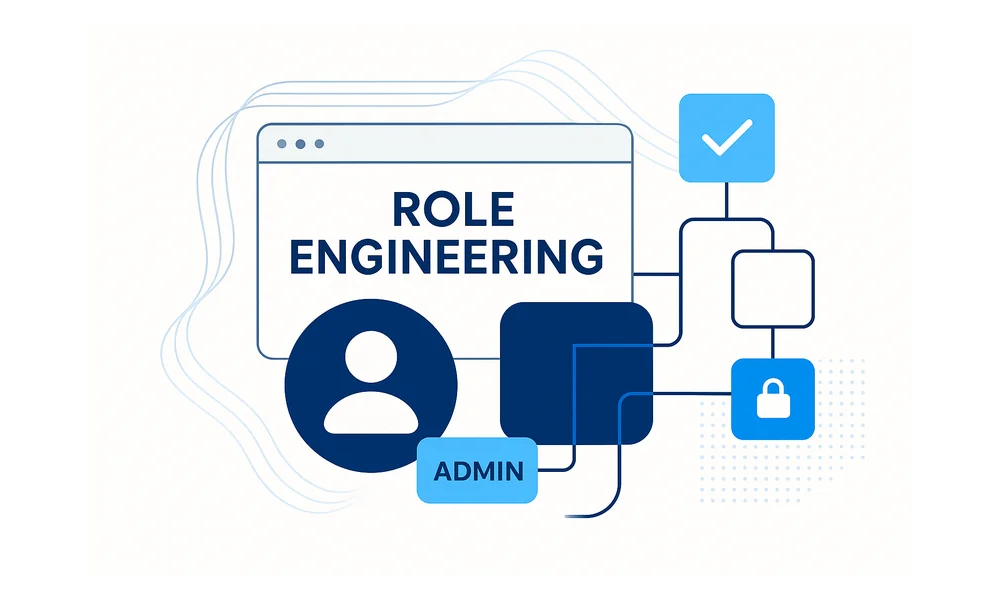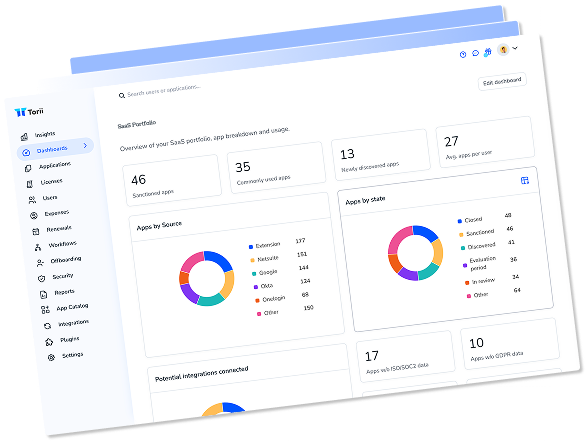What Is Role Engineering and Why It Matters for SaaS Access Management

Role Engineering creates reusable role templates that manage SaaS access consistently at scale across multiple vendors and teams.
It maps business functions, such as Payroll Specialist, to precise entitlement bundles across applications. It also creates artifacts, including a role catalog, entitlement inventory, role-to-process mappings, and named owners for governance and lifecycle control. Role discovery and role mining[https://www.toriihq.com/articles/role-mining-saas-management] tell a different story. Role mining can expose current access patterns and noisy, organization-specific role sets, but without a business-led design to standardize naming, scope, and separation of duties it often leads to role explosion. Role mining is a valuable input but not a substitute.
This article explains Role Engineering for SaaS RBAC and compares it with role mining. It outlines measurable operational benefits and a practical path to implement templates across HR, finance, and development teams, including pilot and governance steps.
Table of Contents
- What is role engineering for SaaS access?
- How does role engineering differ from role mining?
- What operational benefits does role engineering provide?
- How do you implement role engineering across departments?
What is role engineering for SaaS access?
Role engineering creates repeatable, auditable role templates that map jobs to exact SaaS entitlements and simplify access reviews.
This goes beyond a job title and ties business responsibilities to the specific access needed across tools.
The business role is the human-side label while the entitlement bundle is the machine-side permission set granted in each system.
An entitlement bundle lists the API scopes, UI actions, report views, and data objects it grants. Modeling often includes canonical permission IDs, standardized names, short descriptions, and metadata fields like scope, owner, and review cadence.
The engineering work produces reusable artifacts that support governance and scale across dozens or even hundreds of SaaS applications.
- Role catalog: canonical titles, descriptions, and intended business outcomes for each defined role in the organization
- Entitlement inventory: mapped permissions per application with canonical IDs and metadata for owners and review cadence
- Role-to-process mappings: which business workflows each role enables and the key transactions those roles must perform
- Role owners and lifecycle rules: who approves, reviews, and retires roles
These artifacts let teams run audits, measure role reuse, and detect role sprawl without manually inspecting each app.
Effective modeling links roles to controls, enabling segregation-of-duties checks and mapping to policy requirements. That mapping also makes generating crisp evidence for auditors straightforward and simplifies least-privilege reviews across systems.
A “Payroll Specialist” role maps to edit-pay and payroll-report entitlements in Workday and to limited billing views in Salesforce. Because the mappings specify exact entitlements across systems, audits and least-privilege checks become routine and evidence is easy to produce.

How does role engineering differ from role mining?
Role mining and role engineering address access problems from different starting points. They start from different inputs and goals, which leads teams down very different paths when fixing access issues across an organization.
Mining examines logs, entitlement inventories, and clustering outputs to show how permissions are used today. Engineering begins with business intent and designs roles you can govern and reuse. They produce very different artifacts. Mining tends to yield noisy, org-specific role sets and rapid role explosion; engineering gives you clean templates and clearer separation of duties that scale.
Role mining is a telemetry-first activity that surfaces current access patterns and anomalies. It pulls together audit logs, entitlement inventories and grouping algorithm results to reveal islands of privilege, unused entitlements, and overlapping roles that auditors flag. That view works well for baseline assessments and gap analysis because it shows what’s deployed and who’s using it, even when the results are messy and need interpretation.
Role engineering takes business intent as the starting point and crafts reusable role templates. The work maps job functions to precise entitlements, assigns role owners and review cadences, and embeds separation-of-duties checks so roles stay auditable and consistent across apps. Use engineering when you need long-term scale, consistent provisioning, or you’re building RBAC from scratch. It’s an investment that pays off with fewer emergency fixes and simpler audits.
Treat mining as the input and engineering as the resulting, manageable product you deploy across systems. Run mining to establish a clean baseline, then convert clusters and common permission sets into engineered templates you can provision via SCIM or an IDP. Common signals that point toward engineering rather than one-off cleanup include:
- Growing role sprawl across many SaaS apps
- Frequent access-change tickets and emergency grants
- Recurring audit findings tied to inconsistent role names or owners
Platforms like Okta and Azure AD support both discovery and template provisioning, so the handoff from mining to engineering becomes practical and repeatable.

What operational benefits does role engineering provide?
Role engineering delivers measurable, trackable improvements across provisioning, compliance, and operational cost control. Defined roles make it easier to measure outcomes and link changes back to real savings and lower risk across teams.
When roles are defined as reusable templates that map to explicit entitlement bundles, you shrink unnecessary permissions and cut license waste in tools like Salesforce. Clear role-to-entitlement mappings make it obvious which permissions are required for a job, and that visibility stops ad-hoc grants from accumulating. Those limits shrink the attack surface and make audits less painful.
Faster, more consistent provisioning follows naturally once templates exist and are connected to your identity layer. Tying canonical roles to an IDP or HR system via SCIM and provisioning connectors such as Okta often shortens setup from days to hours and reduces manual ticket work. KPIs to track include:
- Mean time to provision or deprovision user accounts
- Number of emergency access or privileged escalation requests per month
- License use rate and cost per seat
Stronger compliance evidence is a direct outcome when role definitions, owners, and review cadences live in a catalog and link back to controls. Auditors ask for role definitions and proof of assignment history, and engineered roles provide both without manual reconciliation. You can automate SoD checks and show an audit trail that ties a declared role to the exact entitlements assigned in each connected application.
Operational teams see downstream gains that are easy to quantify and explain to finance and security leaders. Onboarding becomes predictable, offboarding is immediate, and helpdesk tickets drop because requests for access are routed into predefined role workflows. Those improvements lower administrative headcount, reduce emergency work, and cut licensing waste, giving you tangible KPIs to report: fewer tickets, shorter ramp time, and lower SaaS spend.

How do you implement role engineering across departments?
Start by naming who owns each role and the business process it supports before doing any mapping work. Roles must have clear owners so they can be reviewed and retired when no longer needed. Create a short RACI for HR, finance, and engineering so responsibilities are explicit and handoffs are quick.
Catalog entitlements in each target application and keep that inventory simple and searchable. Use CSV exports or APIs to pull permission lists from apps, then normalize similar entitlements across tools so comparisons are easy. Make entitlement owners part of the catalog so questions reach the right person without chasing committees.
Design canonical role templates with just enough detail to automate provisioning, support audits, and speed reviews. Keep each template focused and consistent by including these fields:
- Title (business-facing), scope (systems and environments), and entitlements (explicit permissions) to make provisioning and audits straightforward.
- Owner and review cadence, including who approves changes, how often reviews occur, and where logs are stored.
- Naming convention and lifecycle rules to ensure IDs are predictable and deprovisioning happens on a schedule.
- Separation-of-duty notes and escalation path, with clear steps for exception approvals and contact points for urgent cases.
For HR, define roles like recruiter, HRBP, and payroll admin with mappings to ATS, HRIS, and benefits platforms. For finance, make narrow roles such as AP clerk, billing reviewer, and controller that limit ledger and billing access. For developers, define teams like engineer, SRE, and CI/CD operator and map them to repo and cloud permissions.
Pilot roles in a small, high-signal slice of systems before broad rollout and automate provisioning where possible. Use SCIM connectors and an IDP such as Okta to sync Workday or your HRIS to cloud apps, and map developer roles to GitHub teams for repo-level control. The Verizon 2023 DBIR highlights credential problems as a common breach cause, so fewer manual permission grants reduce risk and cut cleanup time.
Formalize governance after the pilot by locking down review cadences and recording decisions in the role catalog. Require owners to certify roles quarterly or semi-annually, log each change, and feed access review results back into the catalog so roles evolve with the business.

Conclusion
Role Engineering creates practical order for SaaS access and RBAC across teams and tools. It replaces ad-hoc role lists with consistent templates and clear ownership, making access predictable and auditable across environments.
Role Engineering produces measurable outcomes: entitlement reduction, faster provisioning, stronger audit trails tied to controls, and less admin work. Then it maps a path across HR, finance, and developer teams. Access managers should take note. It also highlights deliverables like a role catalog, entitlement inventory, mappings to business processes, and role owners.
Role Engineering builds role templates and entitlement bundles that enforce SaaS access control and enable governance across teams.

Audit your company’s SaaS usage today
If you’re interested in learning more about SaaS Management, let us know. Torii’s SaaS Management Platform can help you:
- Find hidden apps: Use AI to scan your entire company for unauthorized apps. Happens in real-time and is constantly running in the background.
- Cut costs: Save money by removing unused licenses and duplicate tools.
- Implement IT automation: Automate your IT tasks to save time and reduce errors - like offboarding and onboarding automation.
- Get contract renewal alerts: Ensure you don’t miss important contract renewals.
Torii is the industry’s first all-in-one SaaS Management Platform, providing a single source of truth across Finance, IT, and Security.
Learn more by visiting Torii.
Frequently Asked Questions
Define role owners and a RACI, catalog entitlements per application, design canonical role templates (title, scope, entitlements, owner, review cadence), pilot in a small set of systems, automate provisioning (SCIM/IDP), then lock governance and review cycles.
Role engineering creates reusable, auditable role templates that map business job functions to precise SaaS entitlement bundles. It produces a role catalog, entitlement inventory, mappings, and owners to support consistent provisioning, audits, and least-privilege enforcement across applications.
Role mining analyzes logs and current permission clusters to expose existing access patterns. Role engineering starts with business intent and designs governed, reusable templates. Mining is a diagnostic input; engineering converts clusters into standardized roles suitable for provisioning and long-term governance.
Defined role templates shrink unnecessary permissions and license waste, speed provisioning via IDP/SCIM, reduce emergency access requests, lower helpdesk volume, and produce audit-ready evidence. These improvements yield measurable KPIs like provisioning time, ticket counts, and license cost per seat.
Produce a role catalog with canonical titles and outcomes, an entitlement inventory with canonical IDs and owners, role-to-process mappings tying roles to workflows, and documented role owners plus lifecycle rules for approval, review cadence, and retirement.
Pilot roles in a small, high-signal set of apps, automate provisioning via SCIM/IDP, assign role owners, require periodic certifications, log changes in the role catalog, and feed access-review results back into templates so roles evolve with business needs while preserving auditability.

